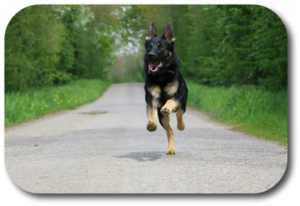Our clients often mention that they see other people walking their dogs on the street without a leash. We always tell them to have their dog on a leash and they just wonder why…

The reason that I am on my soap box about this is because of a conversation I had with one of our clients in Atlanta last night. He told me that often let his dog off the leash when they were in the front yard. There normally was never a problem, but yesterday his dog suddenly took off down the street chasing the trash truck. There weren’t any cars on the street at the time and he finally could get his dog back about two blocks away.
“I have never had this happen before”, he told me. “He plays next door with the neighbor dog and I can play catch with him at the corner park and he always comes right back into the house after me when we are done. The trash truck has passed many times before and he has never gone after it in the past.”
To make things crystal clear, we do not condone having dogs off leash at any time. The reason is that the real world has unlimited things that can distract and engage your dog. Since you can’t plan and train for each of these unique distractions, you can’t universally say that your dog won’t take off down the street. Since you can’t guarantee dog’s safety, we strongly direct our clients to always have their dogs on a leash at all times when they are outside in a non-enclosed area.
No matter where you live, there are always things on the road that can cause danger. As dog owners, it is our job and duty to keep our dog safe from those dangers.
With that said, what are some things you might do to give your dog a little more freedom outside so he doesn’t feel confined to a six foot leash?
Dog Fence: If you like to have your dog in the front yard with you, an underground dog fence is a possible solution. A wire is installed just under the surface of your yard at the edges of your property. This wire will give off a signal to a collar worn by your dog. If the dog gets too close to the wire and your property’s perimeter, your dog will get a mild stimulation (varies based on the dog fence brand). Your dog is trained to understand that when he receives this stimulation, he needs to stop and change direction. It normally takes about a month of daily training to have the dog realize that going near the property’s perimeter is not a good thing.
This system works pretty well if you want your dog to play and stay with you while you are in the front yard. There still is the possibility that your dog will escape the property, but that normally happens under extreme situations. One instance where I observed a normally “contained dog” go through the invisible boundary was with a fully intact male dog rushing to a female dog in heat at the house next door. Again, this is a rare case caused by an incredibly extreme distraction.
Front Yard Tether: This is an “old school method” that can allow your dog some extended freedom in the front yard while keeping him from running into the street. Place a stake firmly in the middle of your front yard. Place a training lead on your dog’s collar or harness and attach the other end to the yard stake. Make sure that the length of the training lead will not allow your dog enter the street or get into any mischief in other parts of the yard. Remain inside the training lead’s circle when you are out with your dog. If you are playing any games like fetch, make sure you don’t throw the toy outside the circle.
Freedom While Walking: Well, when I said “freedom”, I might have stretched the truth just a smidgen. A better term might be “relative, but managed freedom”. Most people walk their dogs on a six foot leash. This provides safety and is the classic “walking tool”. I suggest getting a training lead that is twenty or thirty feet”. You will use this as a moderator, allowing your dog more freedom to passively roam when you feel the time is right. If you are walking in a crowd, the time is’t right. If there are cars coming down the road, the time isn’t right. If you are walking through an empty park, the time is right.
The issue with this method is the need for your constant vigilance. If you have given your dog some extra freedom, you need to monitor the environment to make sure he is still as safe fifteen, twenty, or even thirty feet away from you as if he were right at your side. If you see an issue, bring in the lead and return your dog to your side. When things are safe again, you can give him some lead and room to roam.
No matter where you live, there are always things on the road or out and about that can cause danger. As dog owners, it is our job and duty to keep our dogs safe from those dangers.
Please call Robin or me at (770) 718-7704 if you need any dog training help. We are blessed to have been your local dog training professionals for over fifteen years. We have trained over 5,000 great dogs and loving families and are ready to help you

Follow Us!